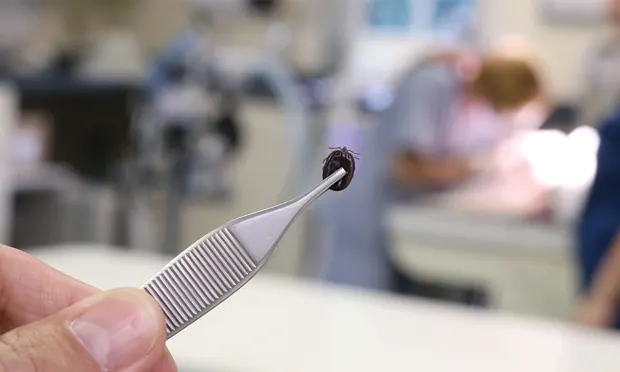Lyme Disease Treatment & Prevention

Lyme disease is a zoonotic, tick-borne disease that has been reported throughout the United States and Canada, with most North American cases reported in the northeast and northwest regions.
The causative agent is the helical bacteria Borrelia burgdorferi, which look similar to the Leptospira species. They do not replicate in the environment but must be injected into the host via attachment of an Ixodes scapularis (eastern blacklegged tick) or Ixodes pacificus (western blacklegged tick); the latter is the only B burgdorferi vector. The bacteria are found in the tick’s intestine where blood is introduced, causing a change in the bacteria’s surface protein. The process takes 24 to 48 hours; after 48 hours, the tick’s saliva contains the bacteria’s infective stage and is introduced into the host’s tissue.
B burgdorferi are obligate aerobes with optimum growth at 28°C to 30°C. Their prevalence depends on the presence of animal reservoirs, while their incidence varies by geographical location depending on the tick's ability to survive on the area’s wildlife.
Related Article: Overview of Lyme Disease in Dogs
Clinical Signs
Clinical signs are seen 2 to 5 months after infection. However, because many animals never show clinical signs, most companion animals (eg, dogs) test positive as an incidental finding during annual heartworm testing. The incidence of animals with the bacteria may be as high as 60% to 70% in highly enzootic areas. Approximately 5% to 10% of infected dogs present with clinical signs.
Illness severity varies according to the geographical area, infecting strain, and immune response. Some cases involve severe illness and even death. Cats are rarely seen with natural infections of Lyme disease. Cattle and horses seldom show clinical signs.
Clinical signs vary according to species (see Table), but shifting lameness, lymphadenopathy, fever, and lethargy are seen in most animals. Dogs may develop neurologic disease, myocarditis, and nephritis. Horses may change behavior. Clinical signs typically resolve spontaneously in approximately 3 days.
Diagnosis
Diagnosis includes serology, PCR, bacterial culture, and detection of the C6 antibody.1,2 Borrelia spp can be difficult to diagnose because a low number of bacteria are required for infection. PCR is not recommended for screening because of a high incidence of false negative results. A quantitative C6 or Western blot must be performed to confirm a positive result.
Related Article: Ticks at a Glance
Treatment
Dogs presenting with clinical signs should be given doxycycline at 5 mg/kg PO twice a day for 4 to 6 weeks or amoxicillin at 22 mg/kg PO twice a day if allergic to doxycycline.3 Dogs may also need nutritional support, hospitalization, IV fluids, and oxygen therapy depending on the disease severity.
Prevention
Prevention includes vaccinating at-risk animals, checking daily for ticks, and preventing ticks from attaching. Several veterinary products that prevent tick attachment are available. Potential environmental infection sources (eg, wooded areas, brush along wildlife-inhabited fields) should be avoided. Widening paths through wooded areas will decrease the likelihood of tick attachment.
Ticks populate lawns and shrubs as well as wooded areas. Reducing plants that attract deer, keeping grass mowed, removing brush and leaves along stone walls and wood piles, and keeping bird feeders and wood piles away from areas that pets and people frequent also prevents tick attachment.
Conclusion
Veterinary technicians are integral in Lyme disease treatment and prevention. They should be knowledgeable so they can educate clients about disease prevention, the need for vaccination programs in enzootic areas, the formulation of tick-prevention programs, and the importance of client compliance for prevention and protection from infection.
Editor’s note: Meri Hall is a graduate of Central Carolina Community College in Sanford, North Carolina, and a charter member of the Academy of Internal Medicine for Veterinary Technicians. She has a special interest in infectious diseases and has written book chapters and spoken at local, regional, and national conferences on the pathophysiology and prevention of infectious diseases.